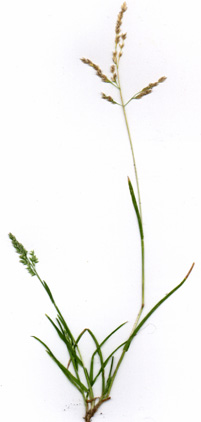
|
| Annual Bluegrass; Poa annua L. |
Grass Family; GRAMINEÆ (POACEÆ)
|
| As its name clearly indicates, this weed is an annual (rarely perennial) grass, amongst the smallest and weediest of all. In the
Language of Flowers, grass perfectly symbolizes utility and submission. However, this particular pest is neither useful nor easily subdued. It's
a worthless eyesore. Of close to 100 wild grass species known in Seattle, this one may be the weediest. Quack-grass, Foxtail, Orchard
Grass, Ripgut, Crabgrass and others are not as common yet are more glamorous. Annual Bluegrass is ubiquitous. |
| It owes its prevalence to lucky chance: In Europe, two generally separate and ordinary grasses are thought to have hybridized
to produce this allotetraploid. Its vigor, plasticity and adaptability let it proliferate at an alarming rate.
Every month of the year, flowering and seeding specimens are easily seen. They are as small as half an inch or up to about a foot tall, and tolerate most soil and light conditions. |
| Book names include: Dwarf Meadowgrass, Low Speargrass and other such trash. But
blue it is not. The grass originally owning
the genuine American vernacular name Bluegrass was
Poa compressa L., also an Old World import. But after the 1811 Battle of
Tippecanoe in Indiana Territory (where William Henry Harrison derived enough fame to elected him President in 1840 with the slogan
"Tippecanoe and Tyler Too") some Kentucky soldiers (it is said) returning to their limestone regions, brought with them some
Poa pratensis L. starts, for they much admired this grass. At the time
Poa pratensis was called Green Grass. Anyway, the way it throve in Kentucky and
Tennessee was famous. Kentucky became the Bluegrass State and American book writers made ALL
Poa species serve under the Bluegrass name! But nonetheless we know full well that these grasses are green as the sky is blue and rain is wet.
Indeed, Annual Bluegrass is distinctly yellowish-green, especially in late spring. |
Because so much of human civilization depends on grasses, we can easier forgive a few weedy kinds by remembering their
valuable kin. Cereal grains include maize, wheat, rye, barely, oats, sorghum and rice. There are grasses for pasture and hay, lawns,
erosion-control and ornament. Sugarcane, bamboos, fiber grasses and miscellaneous kinds round out the impressive list. And ironically, even
Annual Bluegrass has been enslaved: some turf experts figured "if we cannot beat it, let us
use it." So they bred some strains that can be kept
as lawn grasses!
|
Originally published as the Seattle Tilth newsletter Weed of the Month in February 1988, along with an illustration drawn by Jerri Geer.
Back |
|
|

